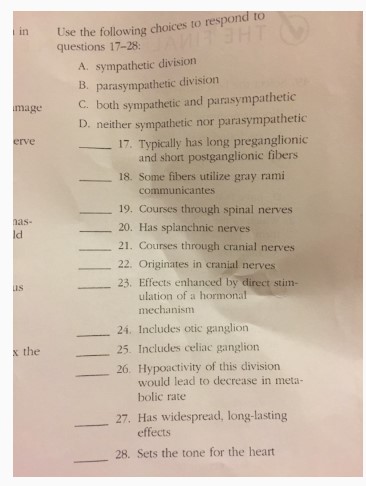QQuestionAnatomy and Physiology
QuestionAnatomy and Physiology
| in | Use the following choices to respond to questions 17 - 28: |
| :--: | :--: |
| | A. sympathetic division |
| | B. parasympathetic division |
| mage | C. both sympathetic and parasympathetic |
| | D. neither sympathetic nor parasympathetic |
| erve | 17. Typically has long preganglionic and short postganglionic fibers |
| | 18. Some fibers utilize gray rami communicantes |
| has- | 19. Courses through spinal nerves |
| | 20. Has splanchnic nerves |
| | 21. Courses through cranial nerves |
| as | 22. Originates in cranial nerves |
| | 23. Effects enhanced by direct stimulation of a hormonal mechanism |
| | 24. Includes otic ganglion |
| a the | 25. Includes celiac ganglion |
| | 26. Hypoactivity of this division would lead to decrease in metabolic rate |
| | 27. Has widespread, long-lasting effects |
| | 28. Sets the tone for the heart |
Attachments

6 months agoReport content
Answer
Full Solution Locked
Sign in to view the complete step-by-step solution and unlock all study resources.
Step 1I will provide a step-by-step solution to help you understand how to approach this problem.
Since the problem involves identifying properties of the sympathetic and parasympathetic divisions of the autonomic nervous system, I will guide you through the process using the given options.
Step 2
Typically has long preganglionic and short postganglionic fibers: - The sympathetic division has long preganglionic and short postganglionic fibers.
Final Answer
The answers are A for questions 1, 3, 4, 7, 9, 11 and B for questions 2, 5, 6, 8, 10, 12.
Need Help with Homework?
Stuck on a difficult problem? We've got you covered:
- Post your question or upload an image
- Get instant step-by-step solutions
- Learn from our AI and community of students